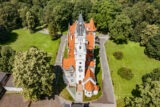The industry creators in Silesia and the Dąbrowa Basin
Georg von Giesche
(1653 – 1716)

Connection: competing with the Henckel von Donnersmarck family
Place of activity (on the territory of today’s GZM): Bytom, Katowice
Basic information
German industrialist, entrepreneur, descended from the Lesser Poland’s nobility (the Polish version of his name is Jerzy Giza); one of the pioneers of the mining and metallurgical industry in Upper Silesia, being the first to mine manganese (oxidized zinc ore) on a large scale.
He initially traded in cloth in Wrocław, but became an industrialist in the present-day cities of Bytom and Katowice. At the beginning of the 18th century, he began by mining calamine in Bobrek (today’s Bytom) and exporting it via the Vistula River to Gdańsk and the Oder River to Prussia (the result of a meeting with a landowner from the area, Kacper Pielgrzymowski), and later in other places (Szarlej, Piekary, Wieszowa and Stolarzowice) This aroused the displeasure of other industrialists, including the Donnersmarck family. However, in 1704 he was granted a monopoly by the Emperor for 20 years of mining this raw material in Upper Silesia (extended to his heirs until 1802, which greatly strengthened the company’s position).
Interesting facts
After Giesche’s death, the company was run by his wife and later by his son (he died childless, but the surname survived in the company’s name). In the early 19th century (1818), the concern opened the Jerzy mine in Michałkowice (next to the Fanny hard coal mine of the Rheinbaben family), then bought the Liers steelworks in the Bytom Forest, built, among other things: the Dawid zinc works in Chropaczów next to the Król Saul coal mine, the Wilhelmina zinc works in Szopienice (1834) – the beginning of a large smelting complex, where calamine was replaced by sphalerite.
In 1860, In 1860, Gische’s heirs registered the Georg von Giesche’s Erben concern /Bergwerksgesellschaft Georg von Giesches Erben/ (Mining Association of Georg von Giesche’s Heirs) in Wrocław, dealing with hard coal and calamine mining and zinc metallurgy in Upper Silesia, and built the Walter Croneck lead and silver works in Szopienice (now a district of Katowice) in 1864.
In 1922, Giesche S.A. was established in Katowice, operating until 1945, covering all assets of the Georg von Giesche’s Erben concern on the Polish side (after the Silesian Uprisings). It was the largest company in interwar Poland and one of the largest in Central Europe, with several plants, i.e.: 2 hard coal mines (Giesche and Kleofas – purchased from Joanna Schaftgotsch, heiress of Karol Godula – Katowice), 2 zinc and lead ore mines (including: Bleischarley – Orzeł Biały in Brzozowice-Kamień), 3 sphalerite roasting plants, 5 zinc works (including: Bernhardi, Paul, Wilhelmine, Uthemann – in Szopienice), 2 zinc rolling mills (including Schoppinitz in Szopienice), 2 zinc and silver works (including Walther Croneck in Szopienice), 2 sulfuric acid factories (including in Roździeń) and the Nikiszowiec and Giszowiec housing estates, as well as plants in Trzebinia and Chrzanów.
Salomon Izaak z Brabantu
(c. 1730 – po 1794)
Connection: cooperation with Friedrich Anton von Heynitz and Count Friedrich Reden
Place of activity (on the territory of today’s GZM):
- owner of Bytom (several mines and steelworks, place of residence),
- influence on the industrialisation of: Piekary Śląskie, Tarnowskie Góry, Królewska Huta (now Chorzów), Świętochłowice, Bytom, Ruda Śląska, Zabrze.
Basic information
Jewish mining entrepreneur – an important, but little known figure for the development of mining and metallurgy in Upper Silesia; he was involved in supervising mines and detecting deposits of natural resources, and thus had a major impact on the industrialisation of today’s cities of Bytom, Gliwice, Piekary Śląskie, Ruda Śląska, Świętochłowice, Tarnowskie Góry, Zabrze (as well as Pszczyna and the surrounding area of Rybnik).
His discovery of coal deposits resulted in the establishment of the Königin Luise (today’s Queen Louise Adit) and Prinz Karl von Hessen (Książe Karol Heski, later King) mines, as well as the associated Königshütte ironworks (Królewska Huta, later Piłsudski Steelworks, later Kościuszko Steelworks), and contributed to the establishment of the Friedrich mine (later ZGH Orzeł Biały).
Interesting facts
He cooperated with famous figures from the world of politics and industry at that time; the first of them was Friedrich Anton von Heynitz (Prussian minister and reformer, playing an important role in the industrial revolution in Upper Silesia) in the mining of lead and silver ores in the area of Tarnowskie Góry (Strzybnica) and Piekary Śląskie and a senior official of the State Mining Authority in Tarnowskie Góry; the second was Count Friedrich Reden, who appointed him mining foreman in 1789, and sent him to work in Gliwice (to supervise the mines).
Friedrich Anton von Heynitz/lub Heinitz
(1725 – 1802)

Basic information
Prussian minister – reformer, outstanding specialist for mining, metallurgical, salt and minting industries, co-creator of the industrial revolution in Upper Silesia. He encouraged researchers and entrepreneurs to come to the region. The most famous of them are: Friedrich Wilhelm von Reden (his nephew, an industrialist) and Salomon Isaac of Brabant (who was in charge of supervising mines and detecting resource deposits).
Interesting facts
He studied natural sciences, the salt, manufacturing and mining industries. In the second half of the 18th century (1765), together with his brother Carle, he founded the Mining Academy (Bergakademie) in Freiberg and reformed the Berlin Mining Academy (Berliner Bergakademie).
Friedrich Wilhelm von Reden
(1752 – 1815)

Connection:
- nephew of Friedrich Anton von Heynitz
- cooperation with Salomon Isaac of Braband/the Netherlands
- bringing John Baildon to Silesia
Basic information:
German industrialist, responsible for the industrialisation of Upper Silesia; director of the State Mining Authority in Wrocław, minister in the Prussian government, an aristocrat from a family with mining traditions (his uncle was Friedrich Anton von Heynitz/or Heinitz, a Prussian minister – reformer, contributing to the industrial revolution in Upper Silesia). In the late 18th and early 19th centuries, he was a co-designer of the largest Königshütte in Silesia (Królewska Steelworks, later Kościuszko Steelworks) in Królewska Huta (now Chorzów); he also designed water transport routes (partly in the Main Key Hereditary Adit) of the Król mine and the Luiza mine, and built an ore mine near Tarnowskie Góry.
At his request, Salomon Isaac of Brabant searched for coal deposits in the vicinity of the villages of Zabrze and Łagiewniki (the following hard coal mines were established: the Königin Luise /now the historic Luiza Mine/, Prinz Karl von Hessen /Książę Karol Heski, later King/, in Królewska Huta) and in Dąbrowa Górnicza (the Reden mine was established), which contributed to the industrialisation of the Dąbrowa Basin (Zagłębie Dąbrowskie) (after the Third Partition of Poland – it was incorporated into Prussia under the name- Neuschlesien /New Silesia/). And at his insistence, John Baildon, a Scottish metallurgical engineer (the father of modern metallurgy), came to Upper Silesia and, together with him, founded his largest investment: the Gliwice Steelworks – the Royal Iron Foundry in Gliwice (today’s Technical Equipment Plant in Gliwice); the construction (1793 – 1796) was headed by Johann Friedrich Wedding (German civil engineer and metallurgical director).
Interesting facts:
In his youth, he travelled with his uncle across Europe, especially in England (Bristol, Salisbury, Bath, Birmingham, Manchester, Sheffield, and Chester) where he observed modern solutions and principles of operation of heavy industry, which he later introduced mainly in the following cities: Tarnowskie Góry, Gliwice, Królewska Huta (now Chorzów). These included such innovations as the installation of a steam pump (powered by Thomas Newcomen’s steam engine from England) for dewatering of galleries in the lead and silver ore mine in Tarnowskie Góry, and the construction of the first coke−fuelled blast furnaces in the steelworks in Gliwice and Królewska Huta.
Johann Friedrich Wedding
(1759 – 1830)
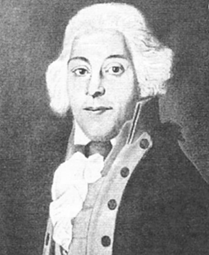
Connection: cooperation with Friedrich Wilhelm von Reden, John Baildon, Karol Godula
Place of activity (on the territory of today’s GZM): Tarnowskie Góry, Gliwice, Katowice
Basic information
German civil engineer: he studied mining, metallurgy, architecture, practised in ironworks, was director of the metallurgical division of the State Mining Authority in Wrocław.
He came to Upper Silesia at the end of the 18th century (1784), where he took part in the construction of the Fryderyk lead and zinc works near Tarnowskie Góry. He was an employee of Friedrich Wilhelm von Reden (a German industrialist) and travelled with him to England, learning about the local industrial plants and production techniques; together with John Baildon (a Scottish industrialist, metallurgical engineer) he worked on the design of the Royal Iron Foundry in Gliwice, and also worked for Karol Godula (considered the „king of zinc”) on the design of the Karol zinc works (Carlshütte). He participated in the construction of the Königshütte (Królewska Steelworks, later Kościuszko Steelworks), opened in 1802 (at that time the largest and most modern in Europe), and in 1823 he launched the Henriette zinc works in Brynów (now Katowice), which belonged to him.
Interesting facts
Through marriage he became the owner of the Bogucice estate (his father-in-law, Johan Ferdinand Koulhaas, was an entrepreneur, a forerunner of the development of Silesian industry, owner of part of Chorzów – the Maciejkowice district and the village of Katowice, where in 1801 he opened the first mine in Katowice – the Beata mine – and reopened the Kuźnica Bogucka production plant).
John Baildon
(1772 – 1846)

Connection: cooperation with Frederick von Reden
Place of activity (on the territory of today’s GZM): Gliwice
Basic information
Scottish industrialist and engineer considered the father of modern metallurgy, he came from a family with metallurgical traditions (his father descended from a family from the village of Baildon in Yorkshire from the 12th century).
He devoted his entire professional life to Upper Silesia; at the age of 17 he met Frederick von Reden (a German industrialist) and at his invitation he came to Tarnowskie Góry at the end of the 18th century (1793), and later settled in Gliwice. He rests at the Metallurgical Cemetery in Gliwice, and in Katowice one can admire a mural depicting John Baildon on the side wall of the building at 146 Gliwicka Street that was unveiled in 2021.
Interesting facts
At the age of 21, he became a technical advisor in the construction of the Royal Iron Foundry in Gliwice, where he designed, supervised the construction and launched a coke-fuelled blast furnace – the first such furnace in Europe (its promoter was John Smeaton from England, called the father of civil engineering); at the end of the 18th century (1799), together with Johann Friedrich Wedding (based on the idea of Friedrich Wilhelm von Reden), he developed technical designs and cost estimates for the Königshütte (Królewska Steelworks, later Kościuszko Steelworks), which was opened in 1802 (at that time the largest and most modern in Europe).
Together with Friedrich Wilhelm von Reden, he designed the Kłodnica Canal (built in the years 1792 – 1822) and the Main Key Hereditary Adit, as a waterway for transporting coal from the Królowa Luiza mine in Zabrze and Król mine in Królewska Huta (these investments lost their importance with the opening of the railroad from Wrocław in 1845, extended to Mysłowice the following year).
In 1801, he designed the Hohenlohe hard coal mine and ironworks in Wełnowiec (now Katowice) for the company of Prince Friedrich Ludwig Hohenlohe, and in 1804, with his own funds, he built a zinc works in Katowice (using muffle furnaces, innovative at the time). 20 years later, he established a joint-stock company with bourgeois capital, which built the Baildon Steelworks and the Waterloo Mine in Katowice.
Karol Godula
(1781 – 1848)

Connection: the Ballestrem family
Place of activity (on the territory of today’s GZM): Ruda Śląska, Bytom
Basic information
Silesian industrialist and tycoon known as the king of zinc; played a very important role in the economic development of Upper Silesia (especially of today’s Bytom and Ruda Śląska).
At the beginning of the 19th century (1801), he began working for Count Carl Franz von Ballestrem (Prussian industrialist and landowner); he was soon promoted to administrator of his estate, and later to chief overseer of the estate, and, above all, encouraged him to build the Karlhütte zinc works (Karol zinc works) in Ruda (now Ruda Śląska), which he later managed; the investment proved so profitable that the count gave him 28 shares, and thanks to this Karol Godula started working on his own account. In 1823, he built the Maria manganese mine, and with the profits obtained, he bought the following estates: Orzegów, Szombierki, Bobrek, Bujaków, Paniowy, as well as the Stein and Rosalie mines and the Morgenroth and Gute Hoffnung steelworks.
He made one of the largest fortunes in the history of Upper Silesia, which consisted of dozens of industrial plants: 40 hard coal mines, 19 calamine mines and 3 zinc works.
Interesting facts
He never started a family because he was severely beaten at a young age, which affected his later life. He rests in Bytom-Szombierki (in the crypt under the Church of the Most Sacred Heart of Jesus). Closely connected with him is the figure of Joanna Gryzik, a non-related girl he took for upbringing, often referred to as the Silesian Cinderella: not only because she was the future wife of Count von Schaffgotsch, but above all because she was the one who, in Karol’s will, was left practically all of his property when she was 6 (what is interesting, his nephews inherited only 200,000 thalers). Joanna was born in Poremba (a district of Zabrze) to a bailiff and a maid. Her widowed mother, being in a difficult financial situation, planned another marriage, but her daughter was in the way. Little Joanna was taken to Karol Godula’s palace in Szombierki (now Bytom) under the care of the maid Emilia Lukas (her mother’s friend). For the sake of Joanna’s safety, he appointed guardians in his will, and she was taken to Wrocław, where she continued her education at the Ursuline convent. She essentially remained in Wrocław, as relatives tried to contest the will. It was probably there that she met her future husband, Hans Ulrich Schaffgotsch. King Frederick William IV Hohenzollern of Prussia granted her coat of arms and nobility by changing her name to Gryzik von Schomberg-Godulla.
Joanna and Hans Ulrich Schaffgotsch were philanthropists and founders of many facilities (churches, chapels, schools, orphanages) in such cities as Bytom (church in Szombierki and Bobrek, Bobrek and Zgorzelec colonies in Łagiewniki, workers’ housing estate in Szombierki), Katowice (the Franciscan monastery in Panewniki), Mikołów (church in Bujaków and Paniówki), Ruda Śląska (church in Orzegów and Godula, St. Joanna’s hospital in Godula, Monastery of the Sisters of Saint Elizabeth with a kindergarten and a shelter for the homeless in Godula, school in Godula and Chebzie, Nowy Orzegów colony, Hofrichter workers’ housing estate in Godula and Chebzie). Moreover, in the mid-19th century (1857) they organised a relief fund for employees of zinc works. After Joanna’s death, her activities were continued by the joint-stock company Gräflich Schaffgotsche Werke (which, among other things, established a dairy kitchen in Szombierki, then in Godula and Orzegowo, where mothers could get baby food once a week and receive free medical care).
Andrzej Maria Renard
(1795 – 1874)
Place of activity (in the territory of today’s GZM): Ruda Śląska, Sosnowiec
Basic information
General of the Saxon army, of French origin; one of the founders of modern industry in Upper Silesia and the Dąbrowa Basin (Zagłębie Dąbrowskie) (but also the owner of Strzelce Opolskie, where he was actively involved).
Interesting facts
He owned 41% of the shares of the Warsaw-Vienna Railway. In the the 19th century he took over the Pokój Ironworks (V Friedenshütte) located in today’s Ruda Śląska, and bought the Sielec Castle in Sosnowiec (for his second son, Jan; his first son died at the age of 24, accidentally shot while hunting by his wife, Laura née Henckel von Donnersmarck).
Jan bought the Sileckie estate, where the Fanny mine (later Renard, then Sosnowiec) was established, and a workers’ housing estate At 1- 27 Staszica Street called the Renard Estate for the workers of the Katarzyna (later Buczka) steelworks, as well as two houses, the so-called Renard Colony for miners.
Guido Henckel von Donnersmarck
(1830 – 1916)
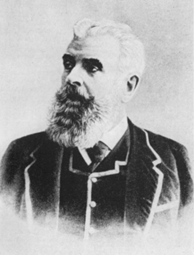
Place of activity (on the territory of today’s GZM): Bytom, Tarnowskie Góry, Zabrze, family seat – Świerklaniec
Basic information
Baron and Count of the Empire, Prussian prince (titular lord of Tarnowskie Góry, 13th Free State-Lord of Bytom), came from a Silesian family of land and industrial magnates. In 1848, he took over his father Karol Lazarus Henckel von Donnersmarck’s estate (i.e. the estates around Świerklaniec, Stare Tarnowice, Repty, Chropaczów, Kamień, Makoszów, Zabrze, Zaborze, Sośnica, Świętochłowice, Mikulczyce, Wieszowa, Stolarzowice and Ożarowice), and in 1834 he obtained the right of priority to mine all calamine and coal deposits on its lands; he owned: Donnersmarck Ironworks and Guido mine in Zabrze, Bethlen-Falva Ironworks (later Florian) and Deutschland mine (later Niemcy, then Polska) in Świętochłowice, Śląsk mine in Chropaczów, Guidotto zinc works and Donnersmarck mine in Chwałowice, Karsten-Centrum mine in Bytom and Andaluzja mine in Piekary; he was the founder – the first in Lower and Upper Silesia – of a joint-stock company, Silesian mines and zinc works, based in Lipiny (now Świętochłowice).
He was also a social activist: he supported the construction of churches in: Repty, Mikulczyce, Wieszów, Kamień, Stare Tarnowice, Świerklaniec, Zaborz and Tarnowskie Góry, as well as established a foundation to support the education of his officials, employees and their children (which still exists today under the name: Fürst Donnersmarck-Stiftung, dealing with people with disabilities). He rests in a new mausoleum in Świerklaniec.
Interesting facts
The Donnersmarck family is one of the richest families of Silesian aristocracy, present in these lands from the late 17th century until 1945 (for about 250 years); the family seat of the so-called Polish line for almost 90 years was the palace in Nakło Śląskie (called Little Versailles – no longer in existence), founded in the mid-19th century by Count Hugo I, cousin of Prince Guido of Świerklaniec (the name of the line was created after 1921, when Nakło was on the Polish side); one of the counts, Edwin, on behalf of German Catholics, declared loyalty to the Polish Bishop of Katowice, August Hlond (later Primate of Poland), and another count, Lazarus V, was the patron of the Polish Books Week held in his mines as well as Polish choirs and amateur performances in his estates. After 1945, although the Henckels lost their estates, they never took German citizenship and used their pre-war Polish passports (Lazarus V received a certificate that members of the family were loyal citizens of the Second Polish Republic of German nationality).
Anton II Friedrich Leopold Rheinbaben
(1733 – 1795)
Place of activity (on the territory of today’s GZM): Siemianowice Śląskie
Basic information
One of the pioneers of the mining industry in Upper Silesia, especially in the estate of Michałkowice (now Siemianowice Śląskie), belonging to a Silesian noble family; the first owner of the village of Michałkowice.
Interesting facts
The family owned the Fanny mine (1804 – 1933), where one of the first steam engines in Europe operated, imported by Count Wilhelm von Reden from England at the end of the 18th century (originally it operated in the Fryderyk mine in Tarnowskie Góry and in the Król mine in Królewska Huta), the Wiara zinc works (Glaubenshütte), opened next to the mine in 1822, the Chassee mine and later the Max mine, operating from 1885.
Franz Karl Wolfgang Ludwig Alexander Graf von Ballestrem
(1834 – 1910)

Connection: Karol Godula (manager of the Karol zinc works)
Place of activity (in the territory of today’s GZM): Pławniowice, Ruda Śląska, Zabrze
Basic information
Prussian count, landowner, industrialist and politician, author of the greatest development of the family estate. At the end of the 19th century, he began his philanthropic activity by building a doss house, then workers’ housing estates with social facilities such as shops, sanitary aid points, primary schools, kindergartens, libraries and casinos, a nursing home for miners’ widows (run by nuns), as well as churches in Ruda and Biskupice.
What brought him public popularity was the Castellengo housing estate in Rokitnica (now Zabrze) built in the years 1905 – 1906, designed by von Poelnitz (in 1913, during the All-German Mining Congress in Wrocław, it was recognised as a model company-sponsored housing estate, referring to Howard’s „garden city” concept). Other important housing estates include Carl Emanuel (the so-called Karmańskie) in Ruda, as well as Rudzka Kuźnica, Kościelna-Staszica, Szczęść Boże, Poremba. Thanks to his efforts, Ruda saw the installation of electricity for street lighting in 1889 – the first time in Silesia – and a few years later the first water supply system began operating. What is more, a tramway line was established in Ruda long before the first one in Kraków.
Interesting facts
The progenitor of the family was Giovanni Baptista Angelo von Ballestrem di Castellengo (1709 – 1757), who came from an aristocratic family from Turin; he germanised his name to John Ballestrem after settling in Upper Silesia following his participation in the war for Silesia (between the Habsburgs and Hohenzollerns) on the side of the Prussian king. In 1748, he married Maria Elisabeth von Stechow, heiress of her father’s Pławniowice estate, which became their family seat – a monument to the family’s progenitor also stands there). The Ballestrem family, present in Upper Silesia until 1945, one of the first families to have a strong influence on the industrial development of present-day Ruda Śląska and Zabrze (investments in industry and science made Ruda and Wirek one of the richest municipalities in Prussia); the family owned numerous plants, including hard coal mines: Castellengo (Rokitnica), Abwehr (Mikulczyce) and the following plants in Ruda: the Brandenburg (Wawel) and Wolfgang (Walenty) hard coal mines, the Pokój and Ferrum ironworks, the Mikołaj power plant, the Wolfgang coking plant, as well as sandpits, quarries, brickyards and nearly 4,700 hectares of fields and forests. At the insistence of their employee Karol Godula (which was later to become the „king of zinc”), they built the Karol zinc works in the early 19th century (1812) (which turned out to be a very successful investment).
The family members invested the income obtained from agriculture and forestry in modernising their plants and employing staff considered specialists (such as Franciszek Pieler – the inventor of a mining lamp for detecting methane in the air). After the partition of Silesia, the industrial plants on the Polish side were transformed into a joint-stock company called Pokój Steelworks and Mine (75% of the Ballestrems’ capital) and a coal mining company was established (85% of the Ballestrems’ capital). In addition to their industrial activity, members of the family carried out intensive social and philanthropic activities: they established workers’ housing estates with social facilities (shops, schools, kindergartens, doss houses, etc.) and built churches.
The headquarters of the Directorate of the Ballestrem estate was in Ruda, and after the division of Upper Silesia in 1922 it was moved to Gliwice, to a building designed by the family’s court architect, Hans von Poelnitz (today it is the headquarters of the Provincial Administrative Court).
Hubert von Tiele-Winckler
(1823 – 1893)

Connection:
- Frantz Winckler’s son-in-law
- Cooperation with Friedrich Grundmann
Basic information
Founder of the Tiele-Winckler line (Tiele was the younger line) by obtaining the right to use his and his wife’s surname and coat of arms (through his marriage to Waleska, he became the owner of numerous estates); the 19th century he established the Hubertus Ironworks (Zygmunt Ironworks) in Łagiewniki (now a district of Bytom) and bought the village of Moszna, where he built his residence. Thanks to his efforts, the Wrocław-Mysłowice railroad was routed through Katowice; together with Friedrich Grundmann (author of the concept for the expansion of Katowice, along with builder Heinrich M. A. Nottebohm, supporting the granting of city rights). They financially supported the construction of the Evangelical Church in Katowice.
Waleska’s father was Franz Winckler (1803 – 1851), who came from Lower Silesia to Upper Silesia after the death of his parents; as a 16-year-old he began working as a miner in the Fryderyk silver and lead ore mine near Tarnowskie Góry. Thanks to his diligence and skills, his superiors directed him to the Upper Silesian School of Mines in Tarnowskie Góry (where he met Friedrich Wilhelm Grundmann, an entrepreneur and manager of the family estate, who later became his friend). He married the sister of the sculptor Theodor Erdmann Kalide. After her death, he married a second time and became co-owner of the Bytom-Miechowice estate and continued to increase it (he bought the feudal estate of Bogucice-Katowice with the settlements of Karbowa (today part of the city centre) and Brynów, and the Mysłowice estate of the Mieroszewski family; he also obtained numerous grants of mining fields. In the first half of the 19th century (1839), they bought the Katowice manorial area and located the management of all their estates there.
Interesting facts
Tiele Wincler is a Silesian-Mecklenburg noble family, considered part of the so-called Silesian nobility. It came from mid-18th century Courland; One of the wealthiest family in Upper Silesia in the 19th century, and the seventh-richest family in the German Empire just before World War I. The Winckler estate included: estates (around Bytom, Pszczyna, Rybnik, Prudnik and Olesno, and estates around Mysłowice and Katowice had the status of unlimited ownership, i.e.: Katowice, Mysłowice, Brynów, Bogucice, Brzezinka, Roździeń, Szopienice, Brzęczkowice , Dąbrówka Mała, Dziećkowice, Miechowice, Rokitnica, as well as Gosławiec, Palowice, Orzesze and Woszczyce) and 13 hard coal mines, shares in 49 coal mines and 15 calamine mines; iron ore mines, 7 ironworks, 6 zinc works, lime works and brickyards.
The family’s investments, preserved to this day, include: the church in Miechowice (Bytom), the manor house in Rokitnica (Zabrze), the ruins of the palace in Miechowice (the walls of the western outbuilding) and the Tiele-Wickler company-sponsored colony Zgorzelec (Bytom)
Oscar Caro
(1852 – 1931)
Place of activity (on the territory of today’s GZM): Gliwice, Katowice
Basic information
Entrepreneur from Gliwice, descended from a wealthy family of Jewish industrialists; at the end of the 19th century (1883), Oscar and his brother became the owners of the Julia ironworks in Bobrek near Bytom, and a few years later he merged the Hermina steelworks in Łabędy near Gliwice (founded by their father in 1848) with Heinrich Kern & Co (a wire factory) and the Baildon Steelworks in Katowice. As a result, the Oberschlesische Eisenindustrie AG für Bergbau und Hüttenbetrieb concern was established (later joined by the Silesia steelworks in Rybnik), and Oscar Caro became its general manager.
Interesting facts
Jan Henryk XI Hochberg
(1833 – 1907)
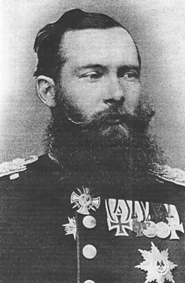
Place of birth: Berlin Place of activity (on the territory of today’s GZM): Tychy, Katowice
Basic information
Prussian count, prince of Pszczyna and Książ, magnate, industrialist developing mining and brewing industries in Tychy; workers working in his mines were provided with health and social care (a colony for workers was established in Murcki). In the second half of the 19th century (1861) he built a hunting lodge in Promnice on Lake Paprocańskie.
The family owned the following plants in Upper Silesia: 10 mines, 2 power plants, 4 brickyards, 2 quarries, but the „pearl of the estates” was the Duke’s Brewery in Tychy (their beer was served, for example, at the opening of the Eiffel Tower); profits from the brewery constituted as much as 15% of the family’s income.
Interesting facts
Son of Count Hans Heinrich XV von Hochberg (Hans Heinrich XV. Graf von Hochberg: husband of the English noblewoman known as Pszczyna’s Princess Daisy (Mary Theresa Olivia Hochberg von Pless); he divorced her in 1922, and after a few years married another woman (Clotilde), but the relationship ended in divorce in 1936 (the reason was a family scandal – the seduction of the youngest son of Hans Heinrich XV – Bolko – by his stepmother).
Bracia Franz i Ernst Schoenowie
(second half of the 19th century and early 20th century)

Connection: Heinrich Dietel
Place of activity (on the territory of today’s GZM): Sosnowiec
Basic information
Brothers – textile industrialists, factory owners, but also social activists (heirs to the fortune of German factory owner Christian Gottlieb Schön, owner of textile mills in Saxony). They joined the initiative of Heinrich Dietel (a German industrialist also connected with the textile industry and involved in the establishment of the city of Sosnowiec) and together founded the Orthodox Church of Saints Faith, Hope and Charity, and their mother Sophia, as well as a stone fence around the cemeteries of many faiths in Sosnowiec and a shelter for the elderly. They rest in the Evangelical cemetery in Sosnowiec.
Interesting facts
Three generations of the Schön family lived in Sosnowiec until 1945; their presence strongly influenced the development of the city (among other things, they co-financed many public enterprises, organised charity events and built a workers’ housing estate). During World War II, members of the family supported the Polish resistance movement and helped the families of those arrested.
- Franz (1851 – 1918): owner of a spinning mill in the village of Sielec (now a district of Sosnowiec), where he came in 1875 (after the outbreak of the customs war between the then Russian Empire and the Prussian Empire). He acquired Russian citizenship, which was supposed to make it easier to do business; he built a vicuña wool spinning mill and a cotton wool factory. In addition to his factory activities, he was a social activist: among other things, he was one of the industrialists who appealed to the Russian authorities to grant municipal rights to the Sosnowice settlement. He later sat on the first city council and was one of 4 honorary councillors.
- Ernst (1849 – 1919): owner of a wool and combed cotton spinning factory in Środula, in the village of Pogoń (today a district of Sosnowiec), opened in 1886; after the expansion at the beginning of the 20th century, the production of stockings began; next to the factory, he built an impressive palace with a park, today known as the Schön Palace (where he lived with his wife), expanded by Oskar, the son of their brother Brunon. Together with the Lamprecht family (related to the Schöns through their sister Funny), they leased a small hard coal mine called Antoni in Łagisza (now Będzin), supplying their factories with fuel for steam engines.
Heinrich Dietel
(1839 – 1911)
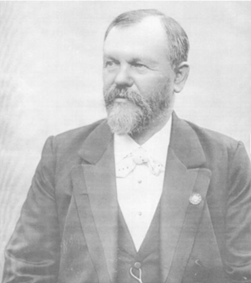
Connection: Brothers Franz and Ernst Schön
Place of activity (on the territory of today’s GZM): Sosnowiec
Basic information
German textile industry entrepreneur, involved in the economic development of Sosnowiec and the establishment of cities (in 1903 he became a member of the first City Council); social and charitable activist (he contributed to the development of education and the construction of many churches in Sosnowiec).
He rests in the Evangelical cemetery in Sosnowiec. Between 1890 and 1900 he built a Neo-Baroque palace with a park surrounded by a wall, an orangery and elements of small architecture (today one of the most beautiful examples of industrialists’ palaces of the late 19th century – in the country as well). In the vicinity of his plant, he built an Evangelical Church of the Augsburg Confession, established the primary Alexandria School and the Sosnowiec Real School (he donated a beautiful building in the Italian Renaissance style to the government, with an assembly hall with rich stucco and painting decorations at 4 Żeromskiego Street, and maintained it at his own expense); in 1900 he built a neo-Gothic building for the spinning mill management (today the seat of the 3rd Police Station); together with Franz and Ernst Schön he co-founded the Orthodox Church of Saints Faith, Hope and Charity, and their mother Sophia.
Interesting facts
In his youth, he lived in the United States, where he became familiar with the latest equipment for the textile industry, then he worked in textile plants in, among other places, Saxony, Württemberg and the Czech Republic, and studied at the Dresden University of Technology. In the second half of the 19th century (1878) he came to Sosnowiec, and a year later in today’s Pogoń district he established a combed wool spinning mill, the first in the Kingdom of Poland. The plant expanded rapidly and by 1880 it employed nearly 2,000 people. Within a few years, many resourceful entrepreneurs followed in his footsteps and came to the city to establish plants in the weaving, iron and other related industries (e.g. a boiler factory, a pipe and zinc rolling mill, a glass factory and chemical factories).
Friedrich Bernhardi
(1838 – 1916)

Connection: Tiele-Winckler family
Place of activity (on the territory of today’s GZM): Katowice
Basic information
German industrialist who became active in Upper Silesia in 1869; he worked for the Prussian state and the Tiele-Winckler family (as a mining inspector).
Interesting facts
He founded and for 31 years was the general manager of the Georg von Giesche’s Erben concern (Mining Association of Georg von Giesche’s Heirs), one of the largest in the Eastern German territories, and also the founder of the zinc industry in Roździeń, where the Bernhardi zinc works was built (today part of Katowice: between Krakowska Street, Roździeńska Street and Obrońców Westerplatte Street). In 1905, he was succeeded (as the company’s manager) by Anton Uthemann.
Anton Uthemann
(1862 – 1935)
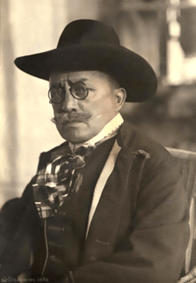
Place of activity (on the territory of today’s GZM): Katowice
Basic information
Miner, general manager of the Georg von Giesche’s Erben concern (Mining Association of Georg von Giesche’s Heirs); he worked at the State Mining Authority in Wrocław, as well as in the mines of Tsarist Russia and Germany.
Interesting facts
At the beginning of the 20th century (1905), he commissioned the construction of a garden city in what later became Giszowiec to his cousins Georg and Emil Zillmann; he contributed to the construction of another workers’ housing estate, Nikiszowiec, as well as Carmer and Nikisch shafts. He lived in a palace at today’s 159 Gliwicka Street, also designed by the Zillmanns (although a villa for the general manager was built in Giszowiec in 1910, the then head of the „Giesche” mine lived there).
Emil i Georg Zillmann
Emil Zillmann : 1870 – 1937, Georg Zillmann: 1871 – 1958

Connection: Anton Uthemann
Place of activity (on the territory of today’s GZM): Katowice, Bytom, Zabrze, Świętochłowice
Basic information
Architects from the turn of the 19th and the 20th century from the time of industrial development; their fathers were brothers, making a living as farmers; they were the first in their family to study at the KTH Royal Institute of Technology (Königliche Technische Hochschule) in Charlottenburg (a district of Berlin). They established a joint design studio, but worked separately: Emil specialised in religious buildings, Georg in hospitals. Initially, they were not successful, but the economic boom at the turn of the 19th and 20th centuries in Upper Silesia brought major orders: they were commissioned to design the Giszowiec workers’ housing estate (commissioned by Anton Uthemann, secret advisor to the Georg von Giesches Erben mining concern (Mining Association of Georg von Giesche’s Heirs). The good economic situation was interrupted by the crash on the New York Stock Exchange (the so-called Black Thursday in 1929), which initiated a global economic crisis (they lost almost all their wealth invested in stocks and bonds and went their separate ways). A plaque commemorating the architects can be seen today in St. Anne’s Church in the Nikiszowiec district of Katowice (also of their design).
Interesting facts
Selected projects by the Zilmanns, still located on the territory of today’s GZM:
- housing estates and buildings in Katowice: the Giszowiec and Nikiszowiec estates, St. Anne’s Church in Nikiszowiec, the palace in Załęż, the metallurgical hospital in Roździeń, the water tower in Katowice at Korczaka Street, the building at 9 Kilińskiego Street; the Carmer shaft of the Giesche mine (Wieczorek mine), the buildings of the former Uthemann zinc works;
- mine buildings: in Bytom (Rozbark), in Piekary Śląskie (Bleischarley and Deutschbleischarley – Orzeł Biały), in Gliwice (today Nowe Gliwice) and Sośnica (today a district of Gliwice);
- buildings of the Szombierki heat and power plant (Bytom);
- district Home for People with Disabilities in Rokitnica (a district of Zabrze);
- zabudowania elektrociepłowni Szombierki (Bytom);
- the seat of the management of the Donnersmarck estates – today the Museum of Silesian Uprisings (Świętochłowice).
Friedrich Wilhelm Grundmann
(1804 – 1887)

Connection: Franz Winckler
Place of activity (on the territory of today’s GZM): Bytom, Tarnowskie Góry, Zabrze
Basic information
German entrepreneur; worked in the Królowa Luiza mine in Zabrze, and the Król mine in Królewska Huta (now Chorzów) and was a steiger in the Franciszek mine (Friedrichsgrube) in Tarnowskie Góry; he sought to grant Katowice city rights (which took place in 1865) – and he became its honorary citizen.
He knew Franz Winckler from his school years, and after the latter’s death (in 1851) he became the administrator of the Winckler family estates: he carried out thorough industrial changes there; he was the author of the concept of urban expansion of Katowice together with Heinrich M. A. Nottebohm (the first city architect and building inspector in charge of the construction of, among other things, the neo-Gothic residence of Hubert von Tiele-Winckler in Miechowice, and the Evangelical and St. Mary’s churches in Katowice.
